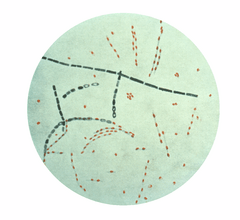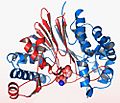Bacillus anthracis facts for kids
Quick facts for kids Bacillus anthracis |
|
|---|---|
 |
|
| Photomicrograph of Bacillus anthracis (fuchsin-methylene blue spore stain). | |
| Scientific classification | |
| Kingdom: | |
| Phylum: | |
| Class: | |
| Order: | |
| Family: |
Bacillaceae
|
| Genus: | |
| Binomial name | |
| Bacillus anthracis |
|
Bacillus anthracis is a tiny, rod-shaped living thing called a bacterium. It's so small you need a microscope to see it! This bacterium is known for causing a serious illness called anthrax.
What is Bacillus anthracis?
This bacterium lives in soil all over the world. It prefers places with mild temperatures. Bacillus anthracis can grow in different environments. It can live where there is oxygen (this is called aerobic). It can also grow where there is no oxygen (this is called anaerobic). This means it's a facultative anaerobe. It can switch between these conditions.
How was it discovered?
In 1877, a scientist named Robert Koch made an important discovery. He was the first to show that Bacillus anthracis causes a disease. Another famous scientist, Louis Pasteur, later confirmed this finding. Their work was a big step in understanding how germs make us sick.
Images for kids
-
CD14 and Mac-1 work together to increase the macrophage internalization of B. anthracis spores. (a) CD14 and TLR2 work in close proximity to propagate the activation signal. Mac-1 starts in a closed confirmation which keeps the integrin from binding the spores, keeping them out of the cell. (b) CD14 binds the rhamnose residues on the BclA of the exosporium leading to TLR2-mediated activation of PI3K. (c) Activation of PI3K pushes Mac-1 into its open conformation so the spore can be bound and internalized (information from Oliva et al. 2009)
See also
 In Spanish: Bacillus anthracis para niños
In Spanish: Bacillus anthracis para niños




